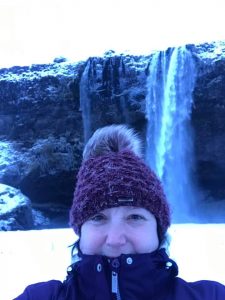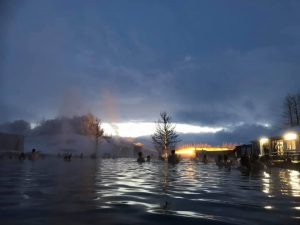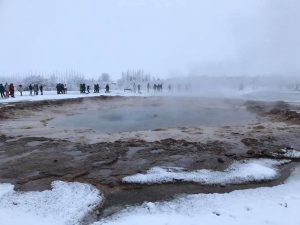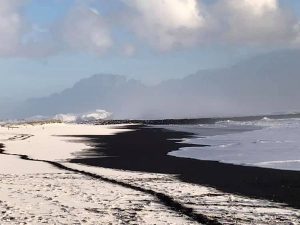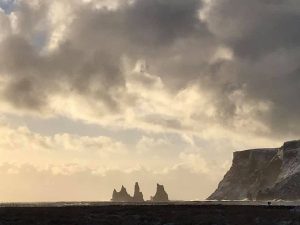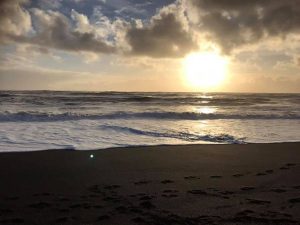
I have been fortunate to visit Iceland twice and would like to share with you my experiences and top tips.
Flights from the UK take around 3 hours, if possible book an early morning flight out so you can make the most of your day on arrival. Iceland is the same time zone as the UK so no concerns about changing watches or jetlag. Iceland is not far from the Arctic circle though so daylight hours are different to the UK. In winter it’s around 4 hours whilst in summer midnight sun is possible. I remember going out for a trip at 10am but it was still pitch black- very strange.
Flights arrive into Keflavik, this is around 45 minutes from Reykjavik. On arrival many people head straight for the duty free shop to stock up as prices in Iceland are much higher than in the UK. The Icelandic gin is very good, we also bought some small bottles of the local spirit Brennivín a schnapps type spirit but haven’t been brave enough to drink it yet (around 40%proof!)
It’s advisable to book your transfer in advance, they aren’t cheap (I will be saying this quite a lot about everything but don’t let that put you off) but by pre-booking they’re budgeted for and gets you a guaranteed seat on the bus.
Much of central Reykjavik is pedestrianised so depending on where your hotel is situated you may have a walk from the bus stop to your hotel (wear your sturdy footwear on the flight so you’re ready on arrival and cuts out some of the weight in your luggage allowance). The bus system is very efficient and you can download a map to show your nearest bus stop, it quickly becomes clear to understand.
Things to do
Northern lights tour
A must do! If you are booking a northern lights tour book this for your first night, if the tour doesn’t go ahead due to the likelihood of poor visibility they will rebook you for the following evening (you will be given a number to call and check around 4pm)
There are various tours, some coach ones and some smaller off road vehicles. If you can afford one of the smaller tours do that as they are much more flexible with where they can get to- a big coach has limited access! The tour leaders have radios and use forecasts to give you the best chance possible. Wear warm clothing and headgear! You are stood outside in the freezing cold (and often bitter wind) waiting for a glimpse. Photographers can take their tripods and the view through the camera lens is often far better than that of the naked eye. Some of my customers have managed to take awesome photos from their phone cameras. Some tours include a hot drink, if yours doesn’t consider taking a flask, but bear in mind there are no loos out in the middle of nowhere!
Golden circle Tour
Another must do. Typically the day tour includes a visit to Thingvellir National Park, the Gullfoss waterfall and the Geysir Geothermal area, it’s a long day (around 8 hours). Some tours can add on a visit to the Secret Lagoon thermal springs- we did this and it was a great way to warm up and relax at the end of an exhilarating day.
Thingvellir National Park declared a World Heritage Site by UNESCO in 2004. It’s undoubtedly one of the main tourist attractions of the Golden Circle and Iceland, because this is where the tectonic plates of North America and Eurasia separate, I’m told this area is featured in Game of Thrones (I’ve never seen it). ‘Gullfoss waterfall gets its name from the golden colour of its water as it churns up silt and sediment. The magnificent waterfalls lie in the Hvitá river and are fed by Langjökull, Iceland’s.second-largest glacier. In total, Gullfoss is 32 meters high, falling two tiers that are 11 and 21 metres high, respectively. The Geysir geothermal area is located in the Haukadalur valley and is the scenic home of the infamous Geysir hot spring. To visit is to pay your respects to the progenitor of all geysers as Geysir is the geyser for which all others are named. Geysir doesn’t erupt often but is surrounded by bubbling cauldrons of superheated mud, steaming pools, and Strokkur, a geyser that erupts every 6-10 minutes’ (Grayline) Be prepared for an assault on the senses as it really pongs (think rotten eggs!).
The Secret Lagoon’s pools are natural (unlike the more famous Blue Lagoon) and steam rising into the air gives the place a magical feeling. The warm water stays at 38-40 Celsius all year. Take your own towel and flip flops, you can rent a locker and towel but your own towels are better. As it’s natural it’s uneven and gravelly under foot but it is a very special experience. I believe you can often see the northern lights from here too, but we weren’t that lucky.
South Coast Tour
A long day with incredible photo opportunities, some tours include a glacier hike too. Volcanoes, sprawling glaciers, and black-sand beaches, the south coast is one of Iceland’s most breath-taking natural attractions. Here’s a typical itinerary “Depart from Reykjavik in the morning, following the North Atlantic coastline down to the south coast. Get your first example of Iceland’s natural beauty as you drive through lava fields surrounding the active Hengill volcano. Steaming springs and fumaroles dot the landscape as you pass, and on clear days you can catch sight of the Hekla and Eyjafjallajökull volcanoes in the distance. Your tour continues to the Sólheimajökull, a breath-takingly photogenic glacier where frosty blue and white ice mingles with dark lava. After being mesmerised by sólheimajökull, make your way to Reynisfjara, where the Atlantic Ocean pounds against black sands and surreal basalt columns that resemble a step pyramid. Make a short stop in nearby Vík, the southernmost village in Iceland, then begin making your way back to Reykjavik. On the way, visit the enormous Skógafoss waterfall, which spans 82 feet (25 metre) in width. Your final stop of your tour before reaching Reykjavik is at Seljalandsfoss, one of the most famous waterfalls in Iceland with a 200-foot (60-metre) drop and a footpath that winds behind the
falls itself.”
It’s worth paying a bit more and booking small group tours as getting on/off the bus a lot can get tedious if you’re waiting for lots of people and the small vehicles can get into less crowded areas. Also book your tours in advance, this will help you to budget for your trip, guarantee your place and ensure you make the most of your limited time.
Other Things to do
There are so many options but the three tours above are must do’s for first timers. If you have longer you can add in a whale watching boat trip, snowmobiling on the glaciers, horse riding, drysuit snorkelling, visit ice caves and hiking to name a few. https://www.travelpack.com/excursion/results is one of my preferred suppliers, have a look at their ‘things to do tab’ I book all these.
The Blue Lagoon is world famous and can be booked in advance, it’s around 45minutes by bus from Reykjavik. I’ve had mixed reviews from my clients, many feel it’s over priced and a bit of a tourist trap, all however have sent me amazing photographs! The Blue Lagoon isn’t natural, it’s a purpose built spa in a lava field with the warm water supplied by the nearby geothermal power plant. There are several packages available, some include drinks, towel hire and meals so check which is the best option for you. It’s open early until late, remember that there are limited daylight hours during the winter. An alternative to the natural pools are the city swimming pools.
https://visitreykjavik.is/swimming-reykjavik Reykjavik has several public swimming pools all heated naturally, great value for a ‘locals’ experience
If you have an hour or so to spare a visit to the city’s Phallological Museum is certainly an eye opener and makes for some fun photos 😉
Hallgrimskirkja Church
A trip to Reykjavik isn’t complete without a visit to the beautiful Hallgrimskirkja Church. At almost 75m tall, it dominates the skyline and is one of Reykjavik’s most important monuments. Easily walkable from the shopping area, but be careful if it’s icy like it was when we went it it’s up a hill and was very tricky with lots of people slipping and sliding!!
Geothermal water is used to heat homes and other buildings, the pipes run below the main shopping streets which keep SOME of the pavements defrosted.
Food and drink
I love to eat out and try local delicacies, I found the food in Iceland tasty, strange and expensive.
Local food includes a lot of fish, you even see various bags of dried fish snacks (like we see Walkers crisps!) on your comfort stops, I have to admit I couldn’t stomach those. Lamb is the main meat source and is delicious, I remember a lovely lamb stew served in a bread roll . A surprise to many, hot dogs are the top street food and SKYR with fruit is lovely (similar to Greek yoghurt and now available in UK supermarkets). Iceland is not a cheap destination, we paid around £25 for fish and chips, £17 for a Baileys coffee and £12 for a slice of cake in a café. My top tip is to take snacks with you (eg cereal bars, crisps, chocolate etc) and have breakfast included in your package.
https://adventures.com/blog/iceland-food/
We ate at the food hall a couple of times food-hall-reykjavik not romantic dining but we had good food and a busy atmosphere.
Don’t buy bottled water! Take a water bottle with you and fill it up with tap water- that water is as pure as it gets, just run the tap for a minute first.
Shopping
Laugavegur is the main shopping street but there are lots of shops throughout the city selling everything from fridge magnets (my must have souvenir)to warm clothing. It’s much better value to shop in the UK for clothes (Sports Direct have a good range of wintersports and thermal wear) There are lots of art type shops with some lovely locally designed jewellery, we bought some unusual xmas decorations and candle holders.
What to wear
Both times I’ve been to Iceland have been in winter and it was bitter. The wind makes it even worse.
I recommend getting a ‘snood’ type scarf to cover your face. It’s also advisable to wear layers, when you’re on the bus or in a restaurant/shop you don’t need the waterproof outer layer on but will do when you step back outside, make sure you can get them on/off easily over your boots too. Denim jeans aren’t the best option as they take a long time to dry when wet. Make sure your
footwear is sturdy and waterproof, within an hour on our first day trip out our feet were wet through (even in waterproof boots) that made for a pretty miserable rest of the day. Day two we wore two pairs of socks with a plastic bag in between them- weird yes but our feet were toasty all day! Take spare socks out with you and don’t forget your gloves.
It’s worth taking a rucksack type bag with you for your excursions- keeps all the spare clothing bits in along with your snacks and souvenir purchases.
Make sure you book enough luggage allowance with your airline, all those layers and snacks add up!
Money Matters
The local currency is Icelandic Krona. You can get your currency before you travel but allow time to order it as most bureaux de change won’t keep it in stock. Credit/Debit cards are widely accepted (some places only take cards not cash) check with your provider for charges. I have found Starling Bank to be excellent with no withdrawal fees at ATMs and an easy app to keep track of spending.
Prices are advertised in stores (written as KR or ISK) and bargaining is not an accepted practice. As I’ve mentioned a few times already, prices are higher than in the UK, especially for alcohol so you need to budget for this.
I hope you have found this useful, if you have any questions or would like me to help plan your perfect Icelandic adventure please get in touch.

